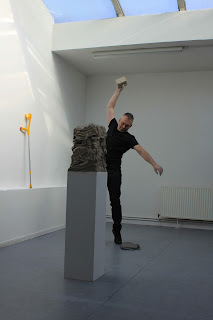atelier:performance #10 - Frank Homeyer
18th of March 2018 - 3 pm
Frank Homeyer wurde 1964 in Hemer im Sauerland geboren. Bereits in den 80er Jahren studierte er als Autodidakt Malerei und Fotografie in Köln. Während dieser Zeit pflegte er einen regen Austausch mit dem Maler und Mentor Fred Elser (*1922), der in der Tradition des Informel steht.

In den 90er Jahren kehrte er sich vorübergehend von der Malerei ab und wandte sich der Fotografie zu. Im Jahre 2000 kam Frank Homeyer wieder zur Malerei. Die Malerei bildet heute - neben seinen Fotoarbeiten - einen wichtigen Bestandteil seines künstlerischen Schaffens.
Ab 2004 öffnete sich Frank Homeyer der Kunst- und Darstellungsform, in der ein Künstler nicht als Interpret sondern als er selbst auftritt: der Performance. Seit 2004 bis heute arbeitet Frank Homeyer national und international mit Performance-Kunst.
Zentrale Themen der künstlerischen Arbeiten von Frank Homeyer sind die Leib/Seele-Problematik, Natur und Psyche. Sein anhaltendes Interesse in verschiedene philosophische und naturwissenschaftliche Ansätze prägt bis heute stark sein künstlerisches Tun. Im Studio : Ilka Theurich performte Frank Homeyer SULPHUR.
ENGLISH VERSION
Frank Homeyer was born in 1964 in Hemer in Sauerland. Already in the 80s he studied painting and photography in Cologne as an autodidact. During this time he had a lively exchange with the painter and mentor Fred Elser (* 1922), who worked in the tradition of Informel.
In the 90s, he temporarily turned away from painting and turned to photography. In 2000, Frank Homeyer returned to painting. Apart from his photographic works, painting today forms an important part of his artistic work. From 2004, Frank Homeyer opened up to the form of art and representation in which an artist does not appear as an interpreter, but as himself: the performance. Since 2004 until today Frank Homeyer works nationally and internationally with performance art.
Central topics of the artistic works of Frank Homeyer are the body/soul problem, nature and psyche. His continued interest in various philosophical and scientific approaches continues to influence his artistic activities. In the Studio : Ilka Theurich he performed SULPHUR.
 |
Photos: Ilka Theurich
|
The following text has been laid out for visitors to read and take away.
Dedication to Painting/Frank
Hoymeyer
It is always interesting to trace the
connection between painting and performance. So many artists are
painting or drawing an environment as they interact with it–some of
them here at WAKE. Traci Kelly/Richard Hancock, Rita Marhaug, Fausto
Gracia, Dominic Thorpe, and Frank Homeyer are mark makers as well as
body artists.
This is a connection that Allan Kaprow
first discovered when he looked at Hans Namuth’s photographs and films of Jackson Pollock at work, painting on glass or just painting
on canvas. Kaprow, who would go on to invent the Happening, realized
that the act of painting was more interesting than the painting. In
fact, Kaprow concluded that painting had played itself out. Maybe he
had read Howard Rosenberg’s article on action painting, or maybe
not–what we can say is that he brought the same degree of messianic
fervor to removing the painting off the canvas that Rosenberg brought
to celebrating the painting on the canvas.
Cowboy art...by men.
One reason to like Frank Homeyer’s
work is that it is performative painting. A glance through his
website shows that in addition to the performance he does a lot of
things, No Way To Utopiapainting being first on the list. And his
performances are both painterly and sculptural.
Some images from Friday night’s
performance include:
- a basin of blue ink with a straw, a reverse sucking action, and a cloth dyed with that ink that was hung from the ceiling.
- Fausto Gracia’s boards and empty white bowls, left in place and incorporated into Homeyer’s performance
- An odd small tree, much like the trees used for model railway cars nailed to the top of a board leaning against a support post.
- A candle nailed to the board below the tree that dripped on the floor and bent into a right angle from the effort.
- A cardboard box mounted on the wall that was set on fire.
- Another candle attached to some sort of metal rod that was used to make a fire drawing on something that looked a lot like a very thick foam core board. There was a strong smell as well. There was a strong smell from quite a few things actually.
On a small scale, the audience was
treated to the fire paintings of Yves Klein or the gunpowder
paintings of Cai Guo-Chiang.
Another reason to like Frank Homeyer:
he doesn’t take his masculinity too seriously.The performance was
funny. Homeyer timed his movements to reflect an external rhythm. He
broke the fourth wall by speaking to the audience. He gave up hanging
the heavy wet blue-dyed fabric in three places and hoped for the
best.
- Jennie
more infos and works about Frank Homeyer:








































